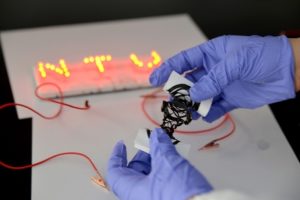Scientists at Nanyang Technological University, Singapore (NTU Singapore) have created a customizable, fabric-like power source that can be cut, folded or stretched without losing its function.
Led by Professor Chen Xiaodong, Associate Chair (Faculty) at the School of Materials Science & Engineering, the team reported in the journal Advanced Materials (print edition 8 January) how they have created the wearable power source, a supercapacitor, which works like a fast-charging battery and can be recharged many times.

Crucially, they have made their supercapacitor customizable or “editable”, meaning its structure and shape can be changed after it is manufactured, while retaining its function as a power source. Existing stretchable supercapacitors are made into predetermined designs and structures, but the new invention can be stretched multi-directionally, and is less likely to be mismatched when it is joined up to other electrical components.
The new supercapacitor, when edited into a honeycomb-like structure, has the ability to store an electrical charge four times higher than most existing stretchable supercapacitors. In addition, when stretched to four times its original length, it maintains nearly 98 per cent of the initial ability to store electrical energy, even after 10,000 stretch-and-release cycles.
Experiments done by Prof Chen and his team also showed that when the editable supercapacitor was paired with a sensor and placed on the human elbow, it performed better than existing stretchable supercapacitors. The editable supercapacitor was able to provide a stable stream of signals even when the arm was swinging, which are then transmitted wirelessly to external devices, such as one that captures a patient’s heart rate.
The authors believe that the editable supercapacitor could be easily mass-produced as it would rely on existing manufacturing technologies. Production cost will thus be low, estimated at about SGD$0.13 (USD$0.10) to produce 1 cm2 of the material.
The team has filed a patent for the technology.
Professor Chen said, “A reliable and editable supercapacitor is important for development of the wearable electronics industry. It also opens up all sorts of possibilities in the realm of the ‘Internet-of-Things’ when wearable electronics can reliably power themselves and connect and communicate with appliances in the home and other environments.
“My own dream is to one day combine our flexible supercapacitors with wearable sensors for health and sports performance diagnostics. With the ability for wearable electronics to power themselves, you could imagine the day when we create a device that could be used to monitor a marathon runner during a race with great sensitivity, detecting signals from both under and over-exertion.”
The editable supercapacitor is made of strengthened manganese dioxide nanowire composite material. While manganese dioxide is a common material for supercapacitors, the ultralong nanowire structure, strengthened with a network of carbon nanotubes and nanocellulose fibres, allows the electrodes to withstand the associated strains during the customisation process.
The NTU team also collaborated with Dr. Loh Xian Jun, Senior Scientist and Head of the Soft Materials Department at the Institute of Materials Research and Engineering (IMRE), Agency for Science, Technology and Research (A*STAR).
Dr. Loh said, “Customisable and versatile, these interconnected, fabric-like power sources are able to offer a plug-and-play functionality while maintaining good performance. Being highly stretchable, these flexible power sources are promising next-generation ‘fabric’ energy storage devices that could be integrated into wearable electronics.”
About Nanyang Technological University, Singapore
A research-intensive public university, Nanyang Technological University, Singapore (NTU Singapore) has 33,500 undergraduate and postgraduate students in the colleges of Engineering, Business, Science, Humanities, Arts, & Social Sciences, and its Interdisciplinary Graduate School. It also has a medical school, the Lee Kong Chian School of Medicine, set up jointly with Imperial College London.
NTU is also home to world-class autonomous institutes – the National Institute of Education, S Rajaratnam School of International Studies, Earth Observatory of Singapore, and Singapore Centre for Environmental Life Sciences Engineering – and various leading research centres such as the Nanyang Environment & Water Research Institute (NEWRI) and Energy Research Institute @ NTU (ERI@N).
Ranked 11th in the world, NTU is top in Asia and has been placed the world’s top young university for the past four years. The University’s main campus is frequently listed among the Top 15 most beautiful university campuses in the world and has 57 Green Mark-certified (equivalent to LEED-certified) buildings, of which 54 are certified Green Mark Platinum. NTU also has a campus in Novena, Singapore’s medical district.
For more information, visit www.ntu.edu.sg
Source: NTU